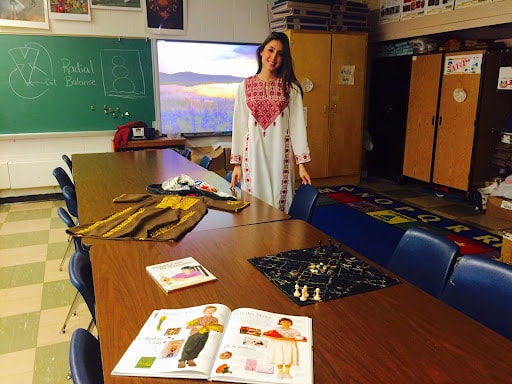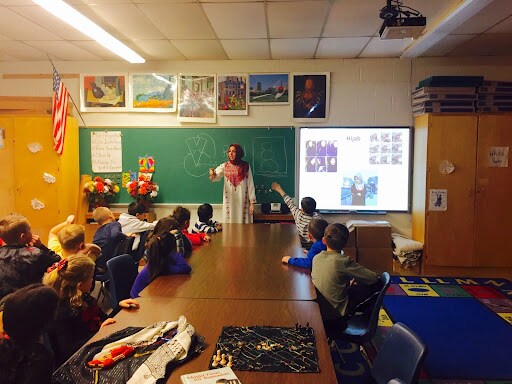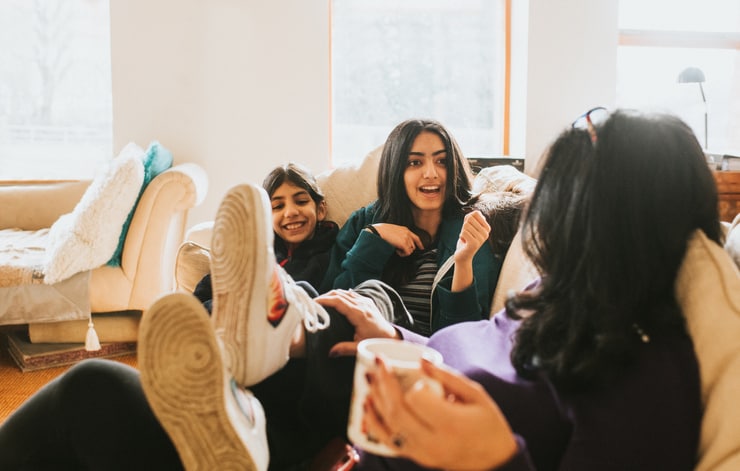Growing up a third-culture kid — a person raised within a different culture than their birthplace or nationality — wasn’t an easy experience, especially as an Arab and Muslim child of the post-9/11 era. Even now, as I explore my newfound confidence in my multiethnic identity in my early 30s, there are memories of loneliness and confusion about where I fit in and who I was supposed to be that stand out when thinking back on my childhood.
As a descendant of refugees and displaced peoples, there was a sense of immense unspoken pressure to honor and respect the culture my grandparents and parents left behind while also assimilating into American society for not only practical reasons leading to a successful future but also for safety. Islamic school on Sundays was a must because in the words of my mother, “All of your friends go to Sunday School or Hebrew school. You are no different.” Taking off school for our religious holidays Eid al Fitr and Eid al Adha were nonnegotiable. Instead of the Lunchables and peanut butter and jelly sandwiches I so desperately craved at lunchtime, the shawarma wraps, Labneh sandwiches and falafel and kibbeh in my lunchbox were topics of conversation at almost every lunch table. And understanding the differences in how I was to carry myself based on expectations deriving from my faith versus what was expected of my peers was no secret to anyone who knew me as “Jenan the Muslim girl” growing up. For as much as I visibly blended in with my classmates, I stuck out like a sore thumb in personality, behavior and family life.
“Instead of the Lunchables and peanut butter and jelly sandwiches I so desperately craved at lunchtime, the shawarma wraps, Labneh sandwiches and falafel and kibbeh in my lunchbox were topics of conversation at almost every lunch table.”
— JENAN A. MATARI, WRITER
As difficult as it was to navigate my own journey in discovering how to properly balance both my American and my Arab cultures, the thought of now helping my own children through the process adds a new layer of stress and pressure that took me nearly 20 years to overcome; however, I do find solace in knowing that I conquered this challenge before and can do so again for my kids.
While I hardly consider myself a parenting expert, I do believe sharing personal experiences can lead to useful advice, and so I’ve put my head together with two actual experts of child and adolescent psychology to compile a list of things parents can do to raise proud, culturally competent and self-aware children.
1. Be open with your children about their multicultural existence — but don’t force them to choose one culture over the other
For many third-culture kids and children of immigrant parents, talking about feelings and personal experience was not something families made a priority. Chalk it up to stigmas surrounding mental health, immigrant parents needing to focus on putting food on the table, whatever the reason may be — it just didn’t tend to happen. But it’s important for parents raising multicultural children today to remember their own experiences growing up and how difficult dealing with the social aspects of school were at times. Just because your child is possibly growing up in a position of a tad more privilege than you did does not invalidate their experiences and difficulties with things like bullies, making friends and fitting in.
“Just because your child is possibly growing up in a position of a tad more privilege than you did does not invalidate their experiences and difficulties with things like bullies, making friends and fitting in.”
— JENAN A. MATARI, WRITER
At the same time, parents must do their best not to put added pressure on their children to “choose a side” or be the perfect representation of their cultural origins for their American counterparts, something I personally struggled with as a post-9/11 era kid in a majority white hometown. I had no option but to be the perfect Arab and Muslim girl because I was the only representation my peers had. The pressure fell greatly on my parents and the rest of our family as well, something never spoken about, but it was surely felt.
Ranim Kaddoura, host of the League of Extraordinary Women podcast and mother of two, thinks back on what she remembers as the most challenging part of her upbringing, “I felt less pressure to honor culture and more confusion about myself associating with one culture or another. I felt lost moreso, growing up. The pressure I felt to honor my cultures came with having kids.”
“I felt less pressure to honor culture and more confusion about myself associating with one culture or another. I felt lost moreso, growing up. The pressure I felt to honor my cultures came with having kids.”
— RANIM KADDOURA, PODCAST HOST
Children, with the right gentle and intentional guidance, can eventually find their own balance of cultures. The natural essence of many third-culture children is that they take all the best parts of their differing identities and blend them into a single third culture all on their own.
2. Get schools and community involved
Whether we like to acknowledge this or not, schools and communities have an obligation to our children to ensure they are accepted by practicing acceptance. Acceptance has huge effects on the emotional development and ability for educational development of our children.
“My parents did an amazing job maintaining a sense of culture in our home and were quite strict on this,” says Kaddoura. “Even when it came to celebrations of Eid, mum would bake Eid cookies, and we’d take them to school or work and share with everyone. But what I felt would’ve helped me,” she explains, “was a greater sense of acceptance in society, not feeling like an ‘other.’ This progression towards acceptance is naturally happening in most parts of the world, and I think this generation won’t have to worry about it as much, I hope!”
“What I felt would’ve helped me was a greater sense of acceptance in society, not feeling like an ‘other.’”
— RANIM KADDOURA, PODCAST HOST
As grown-ups who have gone through difficult times of seeking acceptance (something many of us carry into adult life), it’s our responsibility to expect more from our communal spaces on behalf of our children and fill the gaps we saw as glaring issues in our own experiences so they don’t have to.
“Teachers and administrators have a role in recognizing that third-culture children have a unique set of challenges,” says Shirin Zarqa-Lederman, an adolescent and family psychologist focused on generational trauma through her practice The Diaspora Psychologist. “For example, [these kids] may be responsible for translating if their parents aren’t comfortable with the language. Basic everyday routines may be different, things like bedtime, bathing and lunch meals may be nuanced by culture. It’s important for teachers to recognize these differences exist.”
“Teachers and administrators have a role in recognizing that third-culture children have a unique set of challenges.”
— SHIRIN ZARQA-LEDERMAN, ADOLESCENT AND FAMILY PSYCHOLOGIST
What teachers and educators can do
“Teachers and school administrators can start by asking parents if there are culturally specific traditions or repertoires that their child may need accommodations for,” Zarqa-Lederman advises. “We know that children do better in school when they feel a sense of belonging and attachment to their school. When schools celebrate culture, children feel included.”
“We know that children do better in school when they feel a sense of belonging and attachment to their school. When schools celebrate culture, children feel included.”
— SHIRIN ZARQA-LEDERMAN, ADOLESCENT AND FAMILY PSYCHOLOGIST
Provide children with safe spaces
“Providing a space for them to express their culture would be beneficial for multiethnic children,” she says. “We celebrate St. Patrick’s Day in schools to celebrate Irish culture and take it as an opportunity to learn about Ireland. That can be replicated for children of other ethnicities.”
Make sure representation is core to curriculum
“It’s also important for teachers to include as many different multiethnic representations to children as possible,” adds Zarqa-Lederman. “I’m an advocate of critical race theory, and I believe that American public schools are inherently at a disadvantage by not basing curriculum on it, so I know that teachers are limited in what they can provide in a classroom setting. But I also know that does not excuse us parents from educating our children on what critical race theory is and allowing them to experience learning through the lens of critical race theory.”
3. Talk to kids about challenges you faced growing up and help them prepare to face the similar obstacles
We all have moments growing up where we say to ourselves, “I’m going to raise my kids totally different than how my parents raised me!” But funnily enough, a majority of us end up reusing many of the techniques we once dreaded as we come to the realization that our parents/guardians actually did a pretty good job navigating the difficulties of raising children with the tools and resources they had available to them.
I have chosen to take both the positive and the hard parts of what shaped me into who I am today from my parents’ methods and build upon them with my own extended knowledge and awareness of the world.
Zarqa-Lederman shares how she works to fill the gap of what she felt was missing in her own upbringing as the daughter of refugees. “I never felt like I belonged in either my host culture or the culture my parents came from. Even when visiting my cousins, I was referred to as ‘the American cousin,’ so I really just wanted my kids to feel a sense of belonging that I never had. What I really lacked was extended family — because my family was displaced, my family is scattered all over the world. I didn’t get to grow up with grandparents around the corner or cousins and aunts and uncles like my American counterparts. My husband and I are fortunate enough to have our parents and our siblings close enough so our children have access to that family dynamic now.”
“What I really lacked was extended family — because my family was displaced, my family is scattered all over the world. I didn’t get to grow up with grandparents around the corner or cousins and aunts and uncles like my American counterparts.”
— SHIRIN ZARQA-LEDERMAN, ADOLESCENT AND FAMILY PSYCHOLOGIST
4. Provide kids the space to ask questions and be open to learning together
Likely one of the most difficult practices for immigrant parents can also be considered the most important thing in raising multicultural children to understand, love and accept themselves? Communication.
Kaddoura believes our similarities are far greater than our differences, stating, “It’s incredibly important how parents teach their children culture and how it is communicated. We need to remind our children that culture is a form of expression and draw similarities across various cultures while highlighting how the expression of it is different.”
“We need to remind our children that culture is a form of expression and draw similarities across various cultures while highlighting how the expression of it is different.”
— RANIM KADDOURA, PODCAST HOST
“For example,” she continues, “We all grieve a loss. In Islamic tradition, we express that with a three-day mourning period whilst other cultures express it as a celebration of life. Drawing similarities really helps with the notion of acceptance and is a much more inviting approach to sharing cultural experiences but also helps children foster a sense of belonging to their own. Cultures are not right or wrong, good or bad. Teaching this to our kids will more likely help them assimilate in healthy and inviting ways.”
Kids are naturally curious. As parents and caregivers, we have to make it clear that we are their support system and that we are there to guide them in their own journeys. No questions should be off limits, especially when it comes to exploring one’s identity. The stronger the support system at home, the more likely your child will be successful in finding the confidence needed to guide them through challenges in life, whatever they may be.
5. Find exciting ways to honor their ancestors journeys to where your family is today
Understanding one’s own family history and the struggles and triumphs it took to arrive in your family’s new homeland is crucial for children to grasp who they are. Migration experiences, forced or chosen, are now believed to be passed down through the genetic lineage of families, and children are born with the emotional residue of the lived experiences, particularly the trauma, of their ancestors, i.e., generational trauma.
Zarqa-Lederman says, “Whether it was the child, their parent or their grandparent, their journey to this country and their ability to survive, thrive and raise generations is nothing short of a miracle and should be treated as such. Immigrants rarely celebrate their success. I would suggest choosing a day that is reflective of the family migration experience and reflecting on the trauma of the experience while also celebrating the triumph. It reminds children the stock they come from.”
Ensuring that your child knows their family’s origin stories will become fuel for their own goals later in life, and it will aid them in developing empathy for others’ experiences and realities — something (empathy) it seems many of our older generations are lacking these days when considering how American society is currently treating diversity.
6. Educate and involve their peers
“It’s important that children feel included,” says Zarqa-Lederman, “so if you feel your local community is unaware of cultural nuances that are important to you, I would get involved in your local council or school board. There are subtle ways to incorporate culture in everyday experiences even in a public school district. For example, if the PTA is having a bake sale, offering a cultural baked good is a nice way to start a conversation and educate the school community on different cultures through food.”
My own mom was a trailblazer of this method, as my elementary school classmates even now 20+ years later have vivid and fond memories of the mini assemblies, filled with delicious Palestinian food and beautiful traditional thobes (traditional hand-embroidered Palestinian dresses) my mother insisted putting on for my peers every year, where she’d share bits about our culture and Muslim faith to ensure my friends knew we were “different,” and it should be celebrated.
And now 20+ years later I have taken over my mom’s tradition even before my own children enter elementary school.


From an expert’s perspective, celebrating other cultures and traditions is beneficial for children. “My parents raised us with Islam, and my mother would remind us that the Quran encourages us to celebrate peoples’ holidays with them, so that’s what we did. My parents were supportive of me attending midnight mass with my Irish Catholic best friend, and they came over for lamb during the feast of Ramadan. So that too is a tradition I try and encourage with my children.”
Zarqa-Lederman reflects on her own upbringing, centered around inclusion. “We made it a habit of celebrating holidays that were not ours so they had the experience, and that included holidays like Kwanzaa and Diwali that are primarily cultural, not religious. I would encourage parents to invite their American counterparts to their celebrations.”
The bottom line
Following my very deep, very personal, very self-reflective conversations with our two experts, I can’t help but ask the question I frequently ponder myself: Are the children being raised with a multicultural identity inevitably at risk for feeling like outcasts in society?
Through my identity work over the years, I’ve met literally thousands of people who have connected with my journey to “finding myself” and honoring both my Arab and American identities. The common link? We are all third-culture kids and hyphenated people. People of non-Arab descent were experiencing the exact same dilemmas about fitting into American society, and it made me feel less alone and validated in all I had and still have to say.
If we as a society are practicing acceptance and respect (which, in 2022, there is no reason not to be), says Kaddoura, multicultural kids will be seen as having a richness to them that should be shared and celebrated. However, she adds, “It’s also important to teach our children that other people’s acceptance of them or their culture has less to do with [them] and more to do with the other person and stems from a lack of understanding.”
Zarqa-Lederman believes, too, that it’s important for children to directly engage in their own cultures in order to avoid that sense of feeling lost. “Diasporic mobilization can be a way of reconnecting with culture and meeting other members of the culture to gain that sense of belonging. Without a true homeland, community is all we/they have.”
Whether you’re a current parent/guardian or a hopeful one, an educator, community leader or another member of society, the phrase “It takes a village” stands true. We all have a part to play in raising the next generation of good and aware humans. It’s a collective process and the more we work together, the easier it will become to build future generations of accepting, emotionally intelligent and kind tiny humans. We’re all in this together — literally.





